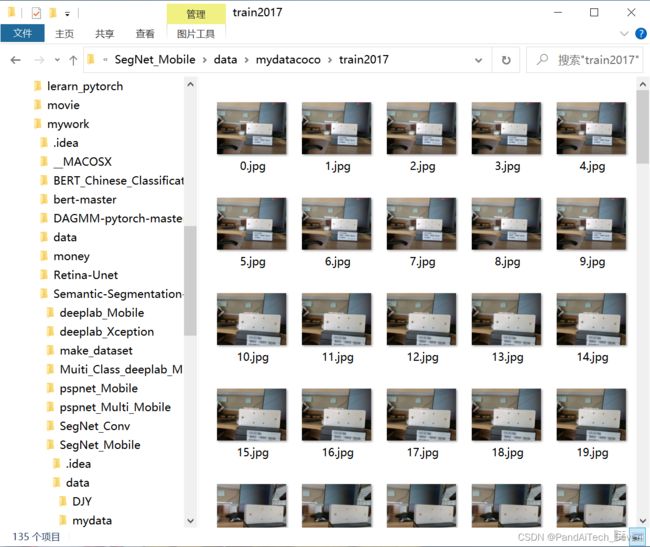mmdetect2d训练自己的数据集(一)—— labelme数据处理
前言
近期在学习mmdetect,总体来说mmlab这个框架感觉上手难度还挺大的,自己也是结合b站各位up主(up主名称:我是土堆、OneShotLove、比飞鸟贵重的多_HKL)以及知乎mmlab官方边看边学,真的是保姆级教程,强烈推荐。但是为了防止以后忘记,记录一下,如果有不对的地方,欢迎大家批评指正。
mmdetect2d训练自己的数据集(二)——模型训练
一、 数据集准备
数据集标注使用的是labelme,关于labelme的使用教程网上有很多,也都很详细,就不过多赘述了。最终获得的文件应该是有一个.png(或.jpg)以及对应的.json文件(标注内容),图片以及对应的annotation名称要一样。如下图所示:
如果标注的时候没有注意的话,可以写段代码重命名一下:
import os
import re
# 运行时将该文件放到和json文件同一目录下,或者直接修改dir_path路径
dir_path = "./"
# 定义正则化规则
formula = re.compile('"imagePath": "(.+?png)",')
for file in os.listdir(dir_path):
# 判定是否是json文件
if os.path.splitext(file)[-1] != '.json':
continue
# 读取json文件
with open(os.path.join(dir_path, file), encoding='utf-8') as f:
content = f.read()
# 根据正则规则找到json文件里的imagePath
imagePath = formula.findall(content)[0]
print('imagePath ', imagePath)
new_content = content.replace(imagePath, os.path.splitext(file)[0] + '.png')
#重命名并保存
with open(os.path.join(dir_path, file), 'w', encoding='utf-8') as nf:
nf.write(new_content)
最终目的是确保在数据处理前,对应json文件的名称能和图片一致。
二、 coco数据集结构形式:
coco数据集对应的文件夹结构树如下所示:

其中,train2017里面堆存训练集图片:

val2017里存放验证集图像:

annotation文件夹里存放对应的标签的json文件:
三、 生成标准的coco数据集格式
labelme生成的json文件是每个图片对应一个,但是coco数据集里是集合起来的,因此需要将其写入同一个json文件。另外,标注时并没有区分训练集和验证集,所以在生成数据的时候需要划分出来,按照自己需要的比例去调节。代码如下:
import os
import json
import numpy as np
import glob
import cv2
from sklearn.model_selection import train_test_split
from tqdm import tqdm
from labelme import utils
# 背景值为0,因此标签对应的mask值应从1开始,根据自己需要识别的种类来。
classname_to_id = {
"hole": 1,
}
class Lableme2CoCo:
def __init__(self):
self.images = []
self.annotations = []
self.categories = []
self.img_id = 0
self.ann_id = 0
# 定义写入json文件的函数
def save_coco_json(self, instance, save_path):
json.dump(instance, open(save_path, 'w', encoding='utf-8'), ensure_ascii=False, indent=1)
# 由json文件构建COCO
def to_coco(self, json_path_list):
self._init_categories()
for json_path in json_path_list:
obj = self.read_jsonfile(json_path)
self.images.append(self._image(obj, json_path))
shapes = obj['shapes']
for shape in shapes:
annotation = self._annotation(shape)
self.annotations.append(annotation)
self.ann_id += 1
self.img_id += 1
instance = {}
instance['info'] = 'spytensor created'
instance['license'] = ['license']
instance['images'] = self.images
instance['annotations'] = self.annotations
instance['categories'] = self.categories
return instance
# 构建类别
def _init_categories(self):
for k, v in classname_to_id.items():
category = {}
category['id'] = v
category['name'] = k
self.categories.append(category)
# 构建COCO的image字段
def _image(self, obj, path):
image = {}
img_x = utils.img_b64_to_arr(obj['imageData'])
h, w = img_x.shape[:-1]
image['height'] = h
image['width'] = w
image['id'] = self.img_id
image['file_name'] = os.path.basename(path).replace(".json", ".jpg")
return image
# 构建COCO的annotation字段
def _annotation(self, shape):
# print('shape', shape)
label = shape['label']
points = shape['points']
annotation = {}
annotation['id'] = self.ann_id
annotation['image_id'] = self.img_id
annotation['category_id'] = int(classname_to_id[label])
annotation['segmentation'] = [np.asarray(points).flatten().tolist()]
annotation['bbox'] = self._get_box(points)
annotation['iscrowd'] = 0
annotation['area'] = 1.0
return annotation
# 读取json文件,返回一个json对象
def read_jsonfile(self, path):
with open(path, "r", encoding='utf-8') as f:
return json.load(f)
# COCO的格式: [x1,y1,w,h] 对应COCO的bbox格式
def _get_box(self, points):
min_x = min_y = np.inf
max_x = max_y = 0
for x, y in points:
min_x = min(min_x, x)
min_y = min(min_y, y)
max_x = max(max_x, x)
max_y = max(max_y, y)
return [min_x, min_y, max_x - min_x, max_y - min_y]
if __name__ == '__main__':
# 训练前准备
# labelme文件路径
labelme_path = r"F:\mywork\Semantic-Segmentation-master\SegNet_Mobile\data\mydata"
# 储存文件路径
saved_coco_path = r"F:\mywork\Semantic-Segmentation-master\SegNet_Mobile\data\mydatacoco"
# annotation文件路径
annotation_path = os.path.join(saved_coco_path, 'annotations')
# train_img文件路径
train_img_path = os.path.join(saved_coco_path, 'train2017')
# val_img文件路径
val_img_path = os.path.join(saved_coco_path, 'val2017')
print('reading...')
# 创建文件夹
if not os.path.exists(annotation_path):
os.makedirs(annotation_path)
if not os.path.exists(train_img_path):
os.makedirs(train_img_path)
if not os.path.exists(val_img_path):
os.makedirs(val_img_path)
# 获取images目录下所有的json文件列表
print(labelme_path + "/*.json")
json_list_path = glob.glob(labelme_path + "/*.json")
print('json_list_path: ', len(json_list_path))
# 划分训练集和验证集,这里没有区分val2017和tran2017目录,所有图片都放在images目录下
# 验证集和训练集比例为1:9,可以根据自己需要更改
train_path, val_path = train_test_split(json_list_path, test_size=0.1, train_size=0.9)
print("train_n:", len(train_path), 'val_n:', len(val_path))
# 把训练集转化为COCO的json格式
# 将训练集对应annotation的json文件写入同一个
l2c_train = Lableme2CoCo()
train_instance = l2c_train.to_coco(train_path)
l2c_train.save_coco_json(train_instance, '%s/annotations/instances_train2017.json' % saved_coco_path)
# 将训练对应的图片放入train2017文件夹
for file in tqdm(train_path):
# 根据划分的json文件来索引训练集
img_name = file.replace('json', 'png')
temp_img = cv2.imread(img_name)
try:
# 分离文件名与路径
(filepath, tempfilename) = os.path.split(img_name)
# 将文件改为jpg格式,因为coco数据集中都是使用jpg格式
tmp_new_name = tempfilename.replace('png', 'jpg')
# 获取新文件的保存路径
train_img = os.path.join(train_img_path, tmp_new_name)
# 写入图片
cv2.imwrite(train_img, temp_img)
except Exception as e:
print(e)
print('Wrong Image:', img_name)
continue
# 把验证集转化为COCO的json格式
# 将验证集对应annotation的json文件写入同一个
l2c_val = Lableme2CoCo()
val_instance = l2c_val.to_coco(val_path)
l2c_val.save_coco_json(val_instance, '%s/annotations/instances_val2017.json' % saved_coco_path)
# 将验证集对应的图片放入val2017文件夹
for file in tqdm(val_path):
# shutil.copy(file.replace("json", "jpg"), "%scoco/images/val2017/" % saved_coco_path)
img_name = file.replace('json', 'png')
temp_img = cv2.imread(img_name)
try:
# 分离文件名与路径
(filepath, tempfilename) = os.path.split(img_name)
# 将文件改为jpg格式,因为coco数据集中都是使用jpg格式
tmp_new_name = tempfilename.replace('png', 'jpg')
# 获取新文件的保存路径
val_img = os.path.join(val_img_path, tmp_new_name)
# 写入图片
cv2.imwrite(val_img, temp_img)
except Exception as e:
print(e)
print('Wrong Image:', img_name)
continue
至此,数据处理结束。